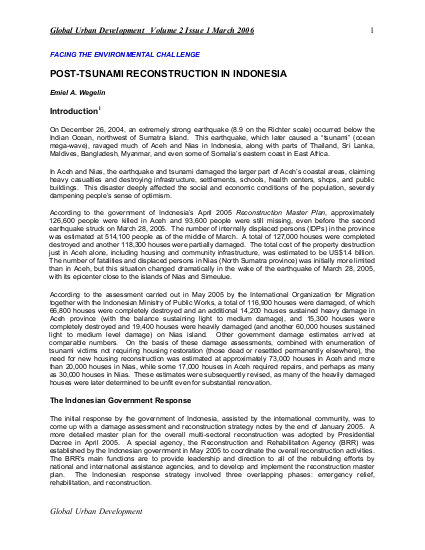
On December 26, 2004, an extremely strong earthquake (8.9 on the Richter scale) occurred below the Indian Ocean, northwest of Sumatra Island. This earthquake, which later caused a “tsunami” (ocean mega-wave), ravaged much of Aceh and Nias in Indonesia, along with parts of Thailand, Sri Lanka, Maldives, Bangladesh, Myanmar, and even some of Somalia’s eastern coast in East Africa.
In Aceh and Nias, the earthquake and tsunami damaged the larger part of Aceh’s coastal areas, claiming heavy casualties and destroying infrastructure, settlements, schools, health centers, shops, and public buildings. This disaster deeply affected the social and economic conditions of the population, severely dampening people’s sense of optimism. According to the government of Indonesia’s April 2005 Reconstruction Master Plan, approximately 126,600 people were killed in Aceh and 93,600 people were still missing, even before the second earthquake struck on March 28, 2005. The number of internally displaced persons (IDPs) in the province was estimated at 514,100 people as of the middle of March. A total of 127,000 houses were completed destroyed and another 118,300 houses were partially damaged. The total cost of the property destruction just in Aceh alone, including housing and community infrastructure, was estimated to be US$1.4 billion. The number of fatalities and displaced persons in Nias (North Sumatra province) was initially more limited than in Aceh, but this situation changed dramatically in the wake of the earthquake of March 28, 2005, with its epicenter close to the islands of Nias and Simeulue.
Resource collections
- UN Habitat - Urban Response Collection
- Urban Response - Urban Crisis Preparedness and Risk Reduction
- Urban Response Collection - Community Engagement and Social Cohesion
- Urban Response Collection - Economic Recovery
- Urban Response Collection - Environment and Climate Change
- Urban Response Collection - Housing, Land and Property
- Urban Response Collection - Urban Crisis Response, Recovery and Reconstruction
- Urban Response Collection - Urban Resilience